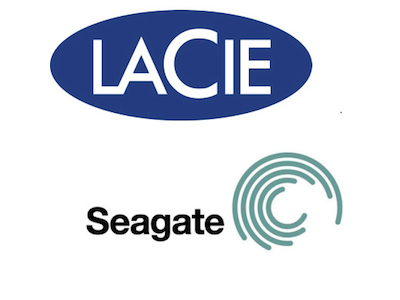Is Seagate Dropping Mainstream Support For Thunderbolt?
A spokesperson for Seagate confirmed on Wednesday that the company is discontinuing mainstream support for Thunderbolt and will only provide the technology on products listed under its LaCie premium brand.
According to the Seagate rep, the lifecycle of the products depending on Universal Storage Module (USM) technology is "coming to a conclusion." This SATA-based tech allowed Seagate’s external hard drives to connect to a variety of devices by way of removable adapters or built-in USM ports on desktops, laptops and more.
News of Seagate’s move to discontinue support for Thunderbolt on its external drives doesn’t spell doom for the technology. In fact, the LaCie division will still continue to offer Thunderbolt-based solutions while Seagate addresses Windows and Mac customers with USB 3.0, USB 3.1 and wireless storage solutions.
Seagate acquired Mac storage provider LaCie back in 2012 for $186 million. As seen on Tuesday, the latest LaCie Thunderbolt-based offering includes the d2, the 2big, the 5big, and the 8big Rack. These devices work on both Windows and Mac machines equipped with Thunderbolt ports and range in price from $299 to $4,599.
As we've seen over the last several years, Thunderbolt is marketed as a USB killer, although the adoption of the technology in the Windows-based arena has been rather slow. Thunderbolt was originally introduced as Light Peak back in 2009 and depended on optical cables. However, to reduce the cost, Intel and Apple decided to use copper wiring instead when the technology launched in 2011. Apple's Macs were the first to utilize the technology, and the Windows-based market has yet to see the same saturation.
For the uninitiated, Thunderbolt provides speeds of up to 10 Gbps while USB 3.0 can clock up to 5 Gbps. The newer standards of each are even zippier, with Thunderbolt 2 seeing 20 Gbps speeds, while USB 3.1 can theoretically pushing data at up to 10 Gbps. The big selling point with Thunderbolt is not only in its speed, but the ability to daisy chain up to six Thunderbolt devices.
Follow Kevin Parrish @exfileme. Follow us @tomshardware, on Facebook and on Google+.
Get Tom's Hardware's best news and in-depth reviews, straight to your inbox.

Kevin Parrish has over a decade of experience as a writer, editor, and product tester. His work focused on computer hardware, networking equipment, smartphones, tablets, gaming consoles, and other internet-connected devices. His work has appeared in Tom's Hardware, Tom's Guide, Maximum PC, Digital Trends, Android Authority, How-To Geek, Lifewire, and others.
-
TechnoD "The big selling point with Thunderbolt is not only in its speed, but the ability to daisy chain up to six Thunderbolt devices."Reply
And USB can chain up to 127 devices. So I don't see how this is a "big selling point."
Also, thunderbolt never was going to be a tech-changing innovation - USB was and is a well-set technology, and the release of thunderbolt wasn't going to change that, at least anytime soon (mass adoption does take its time). -
thundervore So long Thunderbolt, it was good on paper but honestly in real world applications users would rather use USB3 than pay the ridiculous price for thunderbolt. It was basically firewire all over again.Reply
Im happy I didn't decide to get a motherboard with thunderbolt, all the devices out there just didn't seem like it was worth the price. -
ohim Companies should learn to stop producing ports / tech that are mostly proprietary tech and expensive. Apple wanted exclusivity for thunderbolt and manage to somewhat fail about it.Reply
And i`m pretty sure Nvidia`s G-Sync will fade with the introduction of FreeSync that Nvidia cards can also support and have cheaper monitors that will be able to use both GPU makers. -
spdragoo Reply"The big selling point with Thunderbolt is not only in its speed, but the ability to daisy chain up to six Thunderbolt devices."
And USB can chain up to 127 devices. So I don't see how this is a "big selling point."
Also, thunderbolt never was going to be a tech-changing innovation - USB was and is a well-set technology, and the release of thunderbolt wasn't going to change that, at least anytime soon (mass adoption does take its time).
Only six devices? That sounds almost like the old days of SCSI devices...as in pre-USB days, when SCSI was the only way to even "daisy-chain", since serial- and parallel-port devices either required separate physical ports or a physical switching device if you wanted to use multiple devices. -
When they had some crazy loopback from your graphic card to the motherboard through a display port cable, then back out a Thunderbolt port, I knew they had lost their minds.Reply
-
2Be_or_Not2Be If you combine a couple of the comments already made, you can make some shrewd inferences about why Thunderbolt isn't catching on that much.Reply
1) Though co-developed with Intel (maybe primarily by Intel), Apple likely wanted TB to be "their" high-speed interface. The 10Gbps speed of the interface could be touted by Apple, and it would reassure all of the premium buyers that "yes, you're getting the best!" So just like Firewire before it, Apple is the biggest and almost only mainstream ODM/OEM to integrate TB as their new preferred interface. So keeping TB in the mind of customers as being a "Apple" technology, even though it's not exclusive to Apple, suits Apple just fine.
2) The cost to add TB to a motherboard seems like it has been made a bit too high by Intel. You would think if Intel really wanted TB to catch on mainstream, they would find some way to reduce the cost of entry. They aren't makers of a lot of little peripherals, and their chips generally aren't used by the OEMs of items like hard drive enclosures, displays, and other items that could connect to your computer by TB. So they probably have decided to keep the revenue high on this tiny chunk of their overall revenue stream, and likely don't have any real motivation to promote TB. After all, their biggest customer of TB is Apple, and there isn't any need to reduce the price there when Apple customers have already grown used to higher prices. -
JohnUSA Almost any new technology involving hardware connections that Apple has a say in it always fails to be adopted by the PC market.Reply
I never adopt any new technology that involves Apple. They are selfish, never share and make everything so ridiculously expensive. I hate Apple. -
JohnUSA Almost any new technology involving hardware connections that Apple has a say in it always fails to be adopted by the PC market.Reply
I never adopt any new technology that involves Apple. They are selfish, never share and make everything so ridiculously expensive. I hate Apple. -
Wisecracker ReplyThe big selling point with Thunderbolt is not only in its speed, but the ability to daisy chain up to six Thunderbolt devices...
... while heating your house for the Winter.
